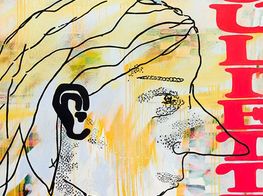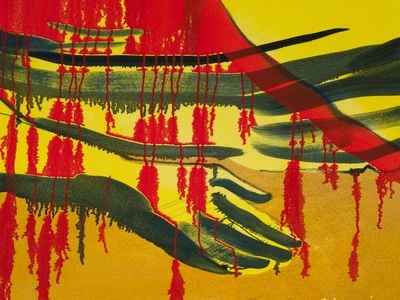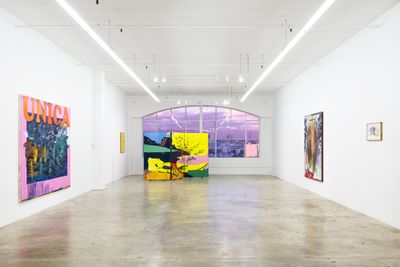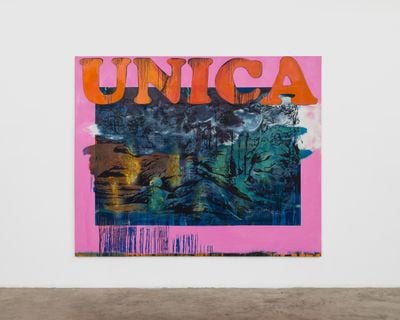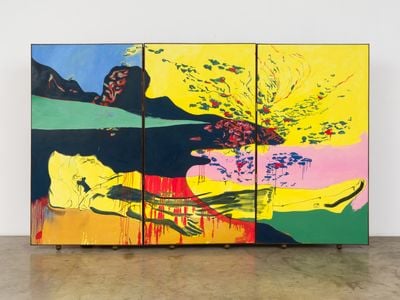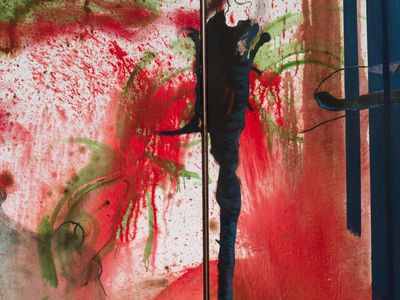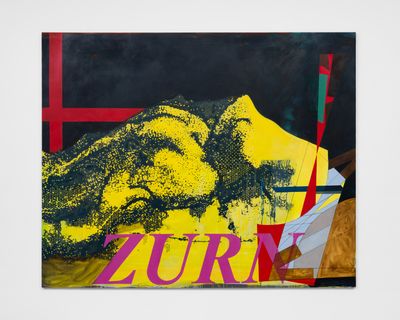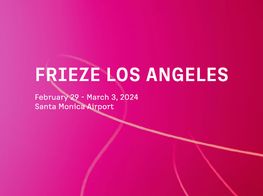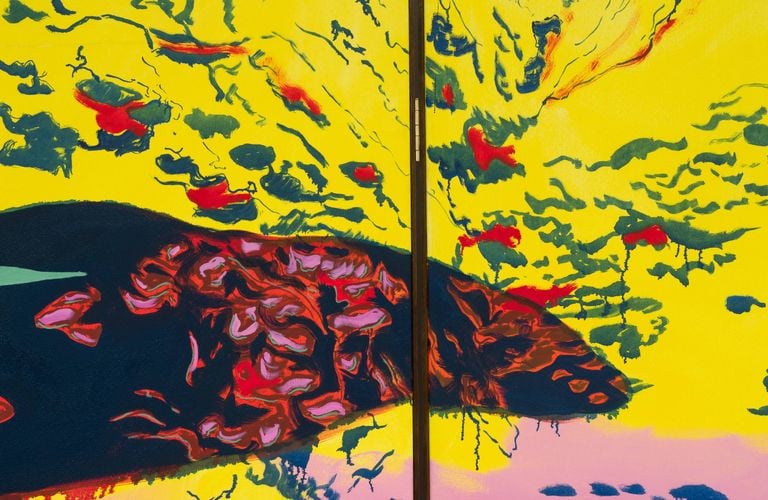
Olivia van Kuiken's Linguistic Painting
Olivia van Kuiken's paintings are concerned with alienation. Forms, shapes and text are pushed to the edge of legibility through a shift in context. Gestural marks and pools of colour are often overlaid with figurative and digital motifs. The resulting fragmented compositions echo the complexity of language as a means of communication both linguistically and visually.
Ahead of her exhibition with Los Angeles gallery Château Shatto, Beil Lieb (24 February–6 April 2024), van Kuiken spoke with Ocula Advisor Rory Mitchell. The young American artist covers a broad spectrum of topics ranging from lyrical poetry to Rhoda Kellogg, Marquis de Sade, and her love of cats.
How did you end up working with Château Shatto?
Château Shatto's director, Harrison Glazier, discovered my work online, which led to a studio visit. Shortly after, I was included in a group show curated by Harrison, where I got to know him and Founding Director Olivia Barrett. We had great conversations, and they were always sending me books relevant to my practice. They also love cats!
When did you first get into painting?
I studied Photography at The Cooper Union in New York, which is where I've lived since 2015. So I didn't go to college expecting to be a painter. Back then, I didn't know you could be an artist. When I started the school, the type of photography being taught didn't speak to me but I became very interested in painting.
Painting, with its extensive and open-ended history, felt less constrained by mechanics compared to photography. I realised that there's so much more to think about with painting. The type of photography I was interested in, alternative process photography—in retrospect, is very painterly.
Before university, were you interested in art?
My high school had art, but it wasn't great. The focus was on mundane activities like printing a picture of Leonardo DiCaprio, gridding it, and duplicating it on paper. I found this nonsensical; why copy a printed image when you could just print it out? It just felt stupid to me.
I had no patience for that kind of thing. I did attend an elective class taught by a retired architect, which I took for four years. Her class informed the way I think about things now. I also took photography classes as a teen after school.
Tell me about some of the influences in your work.
A big moment for me was seeing Ad Reinhardt's work. I remember seeing his paintings for the first time when I was a teenager, and I thought, what is this? This is stupid. When I got to college, I understood his refusal to illustrate meaning, and that early moment was recontextualized.
Today, you can't make a Reinhardt-style painting as it would inevitably reference non-objective painting, becoming a historical nod rather than a fresh perspective. This idea of refusing language in a similar way without just making a blank, monochromatic painting is something I think about a lot. How can I push forms, shapes, and symbols to the edge of their meaning?
As a painter now, I have so many loves in painting. There are lots of painters I respect deeply, but their influence never goes farther than a fling. Whereas Reinhardt sparked a question that I've been following since.
Are you influenced by literature and film?
Absolutely. When I was young, I would watch and obsess over films. As a child or teenager, there's a distinctive experience of shaping your identity through these fictional characters on screen.
Books are an influence too. Linguistically, I reference a lot of lyrical poetry books in my paintings. They can't be referenced or narrativised in the traditional way. I find referencing these books an engaging way to think about crafting a narrative in paintings that feel non-linear.
Tell me about your process. Do you use source materials or preparatory sketches?
I have an extensive archive of both digital and hand-drawn drawings, as well as a collection of shapes I've come across in my daily life.
Previously, my paintings drew specifically from archives focusing on language development among individuals who lack traditional language skills. As I've grown as a painter, my archive has opened up to include forms that enter my life any which way. I think it makes the work less academic and more personal, vulnerable. The practice is always growing.
Even though my archive has expanded, what I'm looking for has remained the same. My primary interest lies in the alienated experience. Previously, I was using archives like the Rhoda Kellogg Child Art Collection's. Kellogg's research on children entering language development is an immediate way to access language in its most alienated form.
I feel now that any shape can be pushed to the edges of its meaning and made flexible with the right context built around it. Language is cultural and geographic, so the right mix of shapes allows for a variety of entry points into the work. Every viewer can approach the work and have a different understanding or experience with it based on their own cultural entry point.
There are often figurative elements in your work. How do you view this in relation to language and human connection?
I want the figures in my paintings to transcend specific identities, avoiding the extremes of beauty or ugliness. I like the idea of them representing normal people, or acting like a stand-in for viewers or an experience that's happening.
In my paintings, the figure represents this edge between you and the world. Figures often dissolve into or emerge from the background, exploring the interplay between body and language as a mediator between our physical existence and the external world.
Thinking about language, I believe it has a role in mediating our understanding of self and the world. It becomes a crucial escape from the alienated experience of being inside our bodies, connecting us to shared human experiences.
What about colour? Do you find your use of colour quite an intuitive process?
Colour is so important to me. It's funny because I started with black-and-white photography, and only embraced colour when I became a painter.
Typically, I begin a painting with a basic idea or shape, applying it in any colour. It's not about being guided by a specific colour from the outset. I start with a concept and let colours interact organically, so they start to respond to each other as the painting evolves.
It never hurts to read some basic colour theory books as well.
The way you play with framing devices and the shapes of canvases is interesting.
Framing is something I've always been interested in because I find rectangles a little boring.
For my exhibition at Chapter Gallery in New York last year, there was limited wall space. I ended up extending one painting across two walls. It created an interesting moment in the space, where you're walking around and the painting is changing, one part disappears while the other part reveals itself. I've always been interested in the relationship between painting and architecture, but this was the first time it had really been employed in my work.
Originally, paintings were integral to architectural settings like caves and churches, but now they've become portable objects moving from fairs to galleries to collectors' homes. I think making work that responds to and enhances the architectural environment, perhaps disrupting it, is more interesting for me and the viewer.
Tell me about digital imagery in your work.
Initially, I avoided putting human figures in my paintings because I wanted them to be entirely abstract. But after reading Justine (1791) by Marquis de Sade, I imagined making a cover for the book, which developed into me making a painting paying homage to it. I began working on these digital drawings just for fun, realising they would be the perfect representation of Justine. From there, digitally drawn faces became a kind of motif in my work.
Using digital imagery is also a way of commenting on the evolving relationship between technology and art. Digital imagery is increasingly woven into our visual culture, so it might as well enter the paintings. While my paintings feature digital motifs, they maintain a playfulness through their hand-paintedness.
Do you think about your lived experience when you're making work?
All the time. There are very personal things in my paintings that come from my own way of being in the world. There are different levels of engagement and different entry points in the paintings that reflect my experiences.
Sometimes I'm thinking about a deathbed painting such as John Everett Millais' Ophelia (1851–1852), or my cat, and that comes through in the work, not necessarily as obvious figures but there are elements of them there.
What are you reading at the moment?
The Marquis de Sade and the Avant-Garde (2020) by Alyce Mahon and The Idiot (1868–1869) by Dostoevsky. I'm also reading a book on the history of set design. —[O]
Main image: Olivia van Kuiken, Untitled (2023) (detail). Oil on canvas, artist frame. 182.9 x 304.8 cm. Courtesy the artist and Château Shatto, Los Angeles.

